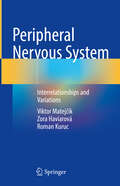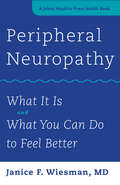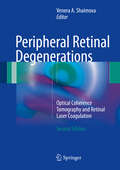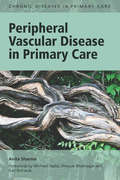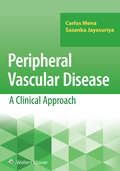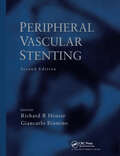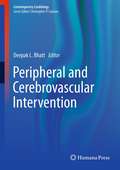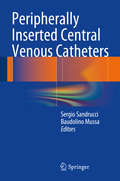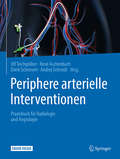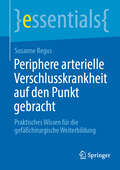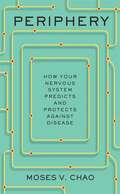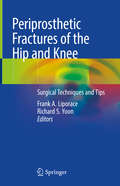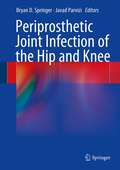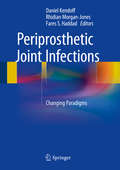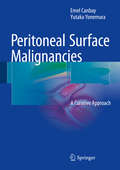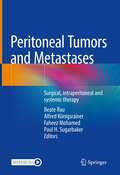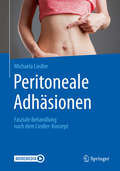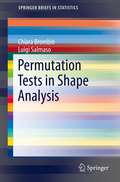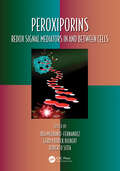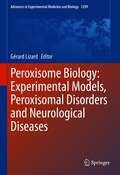- Table View
- List View
Peripheral Nervous System: Interrelationships and Variations
by Viktor Matejčík Zora Haviarová Roman KurucThis book comprehensively evaluates the morphological and clinical aspects of the peripheral nervous system and its involvement in various pathologies. It thoroughly describes its topography, morphology, its peculiarities - that are missing in anatomical and surgical textbooks- and their possible influence on the clinical picture. Their preoperative diagnosis is difficult, even impossible. Figures and line drawings enrich the view of structures that so far. have only been partially documented. The authors' descriptions are based on clinical observations and systematic work on the 246 human bodies of healthy people who died a sudden or violent death (most often in car accidents). Dissection is the most precise method to elucidate the range of variability, which is often largely responsible for the failure of surgical treatments. Their recognition can minimize damage to nerve structures, and the acquired knowledge can help clarify clinical signs and symptoms in surgery or internal medicine. The data presented in this publication will however be useful for traumatologists, orthopedists, spinal surgeons, neurosurgeons, plastic surgeons, as well as neurologists and neurophysiologists, and to all those who are dealing with or are interested in this field.
Peripheral Neuropathies: A Practical Approach
by Mark BrombergDo you find the evaluation of a patient presenting clinical symptoms of distal extremity numbness and weakness daunting and complex? Are you unsure of the diagnostic processes and best-practices in the treatment of peripheral neuropathy? This invaluable guide presents a practical approach to the diagnosis and successful management of patients with peripheral neuropathies. <P><P>Starting with a structured series of patient queries for symptoms and examination signs, the diagnostic process emphasizes the role of electrodiagnostic tests in defining the neuropathy. Specific neuropathies are presented with their epidemiology, causative pathology, diagnostic and laboratory factors, alongside advised treatments and overall management strategies. This leading resource will assist non-neuromuscular neurologists, physiatrists, neurology and physiatry residents, and will also be useful to electromyographers, proving an ideal aid for busy clinic schedules.<P> Presents a full clinical characterization of symptoms and signs of a neuropathy.<P> Shows correlations between electrodiagnostic findings and underlying pathology.<P> Classifies neuropathies by type.
Peripheral Neuropathy: What It Is and What You Can Do to Feel Better (A Johns Hopkins Press Health Book)
by Janice F. WiesmanHealing and symptom relief from an expert in treating this debilitating and dangerous condition.Nearly one in fifteen people—that's 20 million people in the United States—suffers from peripheral neuropathy, or nerve damage. Caused by such conditions as diabetes, cancer, vitamin deficiencies, and kidney disease as well as certain drugs and toxins, neuropathy brings numbness, tingling, and burning in the feet, legs, and fingertips. Neuropathy can be more than uncomfortable—it can be disabling: people whose fingertips are numb may find it hard to button clothing and complete other everyday tasks. Neuropathy is often dangerous, as well: people who cannot feel their feet are more likely to stumble and fall, and they may not notice injuries that need medical attention. Dr. Janice F. Wiesman, a neurologist with twenty years of experience helping people who have neuropathy find relief, shares her special insights into this painful and debilitating condition. With exceptional clarity, Dr. Wiesman begins by outlining the basics of nerve anatomy and function. She explains how peripheral neuropathy is diagnosed and treated, describes neuropathy’s disparate causes, and offers readers lifestyle changes that can help keep nerves healthy. A useful glossary defines terms, patient stories offer real-world experiences, and illustrations provide a visual key to the condition. A detailed resources section points the reader to reliable web sites and organizations that offer more help.Concentrating on the most common types of neuropathy, Dr. Wiesman provides hope, help, and comfort to patients, families, and caregivers.
Peripheral Retinal Degenerations
by Venera A. ShaimovaThis book provides an illustrated guide to peripheral retinal degenerations and the role of spectral domain coherence tomography (SD-OCT) in diagnosis and treatment. The book discusses 73 clinical cases and gives detailed information on the principles of SD-OCT and its application in the imaging of peripheral retina. Peripheral Retinal Degenerations: Optical Coherence Tomography and Retinal Laser Coagulation, 2nd edition, discusses a broad range of retinal pathologies such as chorioretinal degenerations, posterior vitreous detachment, vitreoretinal adhesions and tractions and includes a plethora of high-quality clinical images throughout. Ophthalmologists and retinal specialists will find this updated edition to be the perfect didactic resource for furthering skills and knowledge in this clinical area.
Peripheral Vascular Disease in Primary Care (Radcliffe Ser.)
by Anita Sharma'Peripheral vascular disease is common and has a significant adverse effect on the quality of life. A general practice with a list size of 6000 patients will have approximately 30 symptomatic patients with peripheral vascular disease' - Anita Sharma Peripheral vascular disease is a commonly neglected condition and therefore often presents in an advanced stage or in a life-threatening manner. General practitioners can play a vital role by making early diagnoses, prompt referrals, and in coordinating vascular risk factor management in primary care. This book is a concise and practical guide to recognising, managing and reducing the cardiovascular risk factors in patients with peripheral vascular disease (PVD). Completely up-to-date, it offers clear direction for all primary care professionals. 'A pleasure for any busy professional to read and an excellent source and reference book for all primary care professionals. Students, nurses and registrars will be surprised with the descriptions of various pathologies simply explained, which they will seldom have noticed while working on hospital wards.' Dr Michael Taylor, in his Foreword 'A welcome source of knowledge and information, particularly for those working in the primary care setting with the aim of improving their standards of care.' - Dr Deepak Bhatnagar, in his Foreword 'Anita Sharma is an experienced, practising GP whose book on PVD offers new insights for primary care professionals and is a generous contribution to the work of primary care practitioners everywhere.' - Gail Richards, in her Foreword
Peripheral Vascular Disease: A Clinical Approach
by Carlos Mena Sasanka JayasuriyaPart of the new Clinical Approach series—which focuses on key topics in cardiology—this pragmatic, comprehensive guide is intended for residents, practitioners, advanced practice nurses, and physician assistants, and covers arterial, venous, and lymphatic diseases. Easy-to-read chapters are written by clinical experts in interventional cardiology, interventional radiology, vascular surgery, and podiatry, and begin with helpful quick-reference summaries.
Peripheral Vascular Stenting, Second Edition
by Richard R Heuser MD FACC FACP Biamino GiancarloPeripheral vascular disease is a common, disabling malady, and patients seeking treatment may turn to their cardiologist for advice and treatment. Conventional treatment has always been medical management and, inevitably, surgical bypass, even amputation. Stents have had a significantly high impact on endoluminal treatment outcomes by preventing injury to the lumen, reducing the potential for hyperplasia and restenosis, as well as the likelihood of plaque disruption and embolization. This second edition brings together a combination of all the current evidence-based information with personal experience and is presented by a team of distinguished operators.Short Contents
Peripheral and Cerebrovascular Intervention
by Deepak L. BhattPeripheral and Cerebrovascular Intervention draws upon experts from diverse fields to provide readers with a comprehensive foundation for understanding and performing endovascular procedures--from the basic steps to the most current and advanced techniques. Individual chapters focus on primary intervention sites, including lower extremity, renal/mesenteric, subclavian/upper extremity, carotid/vertebral, intracranial, and venous interventions. Additionally, chapters covering critical limb ischemia and abdominal and thoracic aortic aneurysms are included. By incorporating valuable clinical information, such as indications, contraindications, complications, and discussions of surgical techniques and procedures, this book is a valuable resource for the busy practitioner and will be of interest to all interventional and general cardiologists, radiologists, and neurologists; vascular surgeons; internists; and residents and fellows.
Peripheral, Head and Neck Surgery
by Brendon J. CoventryPeripheral, Head and Neck Surgery is part of the series: Surgery -Complications, Risks and Consequences edited by Brendon Coventry.
Peripherally Inserted Central Venous Catheters
by Sergio Sandrucci Baudolino MussaIndications for central venous cannulation in critically ill patients have increased dramatically, but central venous access has the drawbacks of morbidity and a scarcity of experienced operators. Ultrasound-guided peripheral venous access offers a solution, in that it reduces morbidity and can be performed by a dedicated nursing team. The aim of this book is to teach the fundamentals of this emerging technique. Advice is provided on choice of materials; maneuvers for positioning of peripherally inserted central venous catheters (PICCs), techniques for evaluation of PICC tip placement; prevention, diagnosis, and management of complications; and organization of a dedicated team within a hospital or a supportive care program. Legal and economic issues are also considered. The book will be of interest to a wide range of professionals, including nutritionists, oncologists, anesthesiologists, surgeons, registered nurses, nurse practitioners, physicians, physician assistants, and radiologists.
Periphere arterielle Interventionen: Praxisbuch für Radiologie und Angiologie
by Ulf Teichgräber René Aschenbach Dierk Scheinert Andrej SchmidtDieses Praxisbuch fasst den aktuellen „State of the Art“ der peripheren arteriellen Interventionen in kompakter und übersichtlicher Weise für den Leser zusammen. Das interdisziplinäre Autorenteam aus Radiologen, Angiologen und Gefäßchirurgen hat dabei Wert auf schnellen und geballten Wissenstransfer der doch teilweise sehr komplexen Themengebiete gelegt. Dabei werden alle Facetten der interventionellen Therapie der pAVk der unteren Extremität beleuchtet.Sowohl Einsteiger als auch Fortgeschrittene finden alle relevanten Informationen -angefangen von der klinischen Untersuchung, Diagnostik sowie Vor- und Nachbehandlung der Patienten bis zu peripheren Interventionen- strukturiert dargestellt. Neben den Einführungskapiteln zeigen spezielle Kapitel alle gängigen und spezialisierten Verfahren zur Rekanalisierung von peripheren arteriellen Gefäßen der unteren Extremität auf.Inhaltliche Schwerpunkte: Aufklärung und Vorbereitung Materialkunde Diagnostische Methoden (CT, MRT, Ultraschall, Angiographie) Strahlenschutzaspekte Antikoagulation Ballonangioplastie „Drug-eluting“-Technologie Stenting Lysetherapie Thrombektomie Artherektomie Kritische Ischämie Dieses Buch ist für den Arbeitsplatz gedacht und als Praxisbuch konzipiert. Viele praktische Tipps der Autoren sollen Ihnen im Alltag helfen, schnell und effizient das individuelle Therapiekonzept für Ihre Patienten zu finden.
Periphere arterielle Verschlusskrankheit auf den Punkt gebracht: Praktisches Wissen für die gefäßchirurgische Weiterbildung (essentials)
by Susanne RegusAnhand zahlreicher Beispiele und Situationen aus dem Klinikalltag wird das Krankheitsbild der peripheren arteriellen Verschlusskrankheit Schritt für Schritt erläutert. Der Fokus liegt auf den für die klinische Tätigkeit wichtigen Aspekten von Diagnostik und Therapie. Ein typisches Fallbeispiel durchzieht die Darstellung als roter Faden. Weitere Bände zu anderen gefäßchirurgischen Erkrankungen sind geplant.
Periphery: How Your Nervous System Predicts and Protects against Disease
by Moses V. ChaoA leading neuroscientist argues that the peripheral nervous system, long understood to play a key role in regulating basic bodily functions, also signals the onset of illness.The central nervous system, consisting of the brain and the spinal cord, has long been considered the command center of the body. Yet outside the central nervous system, an elaborate network of nerve cells and fibers extends throughout our bodies, transmitting messages between the brain and other organs. The peripheral nervous system, as it’s known, regulates such vital functions as heart rate, digestion, and perspiration and enables us to experience the barrage of sounds, tastes, smells, and other sensory information that surrounds us. But beyond these crucial roles, the peripheral nervous system might do even more: it might warn us of diseases in our future.As Moses Chao argues in Periphery, from Parkinson’s disease to autism to dementia, many neurological conditions emerge not in the brain but rather within the peripheral nervous system, in the dense network of nerves that wrap around the gastrointestinal tract. What’s more, dysfunctions of the peripheral nervous system can signal the onset of disease decades before symptoms like tremor or memory loss occur. Fortunately, unlike nerves in the brain and spinal cord, peripheral nerves can heal and regenerate in response to injury and aging. The therapeutic implications are remarkable. Chao shows how, with a better understanding of the peripheral nervous system, we could not only predict and treat neurological diseases long before their onset, but possibly prevent them altogether.Full of new ideas and bold interpretations of the latest data, Periphery opens exciting avenues for medical research while deepening our understanding of a crucial yet underappreciated biological system.
Periprosthetic Fractures of the Hip and Knee: Surgical Techniques and Tips
by Frank A. Liporace Richard S. YoonThis up-to-date, comprehensive yet concise guide for orthopedic surgeons covers the salient points of anatomy and operative approaches for the management of periprosthetic fractures of the hip and knee: breaks in bone that occur around the components or implants of a total joint replacement. The opening chapter focuses on the general considerations and work-up of these injuries, including epidemiology, classification, anatomy, and knowledge of the biomechanics and biology behind the treatments. The subsequent sections then discuss the hip and knee, respectively, and are case-based. These describe management strategies for the particular periprosthetic fracture with either a stable or a loose prosthesis as well as associated complications, including fractures of the acetabulum, the greater trochanter and proximal femur, distal femur, tibia, and interprosthetic and interimplant fractures.Written by experts in the field and replete with plentiful, practical tips and tricks, Periprosthetic Fractures of the Hip and Knee is a valuable resource for orthopedic and trauma surgeons, residents and fellows.
Periprosthetic Joint Infection of the Hip and Knee
by Javad Parvizi Bryan SpringerPeriprosthetic Joint Infection of the Hip and Knee is a practical reference for the diagnosis and treatment of total joint infections following hip and knee arthroplasty. In addition to useful chapters presenting common tests and algorithms used for diagnosis, the book gives background on the epidemiology, risk factors, and prevention strategies of periprosthetic joint infection. Additionally, practical clinical information is given, including antibiotic treatment strategies and delivery methods and medical optimization techniques for physicians to follow for patient care and follow-up. Covering a topic that is currently underrepresented in the medical literature, Periprosthetic Joint Infection of the Hip and Knee will be useful to orthopedic surgeons, rheumatologists, and other physicians involved in the care of patients with hip and knee prosthetic implants.
Periprosthetic Joint Infections
by Daniel Kendoff Rhidian Morgan-Jones Fares S. HaddadThis book provides a state-of-the-art,worldwide overview of treatment options available for periprosthetic joint infection(PJI). It highlights areas where tremendous progress has been made over thepast few years, looking at current evidence, projecting a way forward, anddiscussing key topics where ongoing research is needed and could potentiallyhave a huge impact on the field. In addition to familiarising readers with effectivediagnostics and treatment strategies, factors such as socioeconomicsand associated morbidity are also examined in relation to thisincreasingly common condition. Periprosthetic Joint Infections: Changing Paradigms includes expert guidance based on the best available evidence and practice thatcan be applied in even the most difficult infection cases. To create thiskeystone resource for the orthopaedic community, the editors have broughttogether prominent experts from Europe and the US to give an international,authoritative perspective on this important topic. This book is an essentialguide for specialists who deal with challenging cases of PJI in clinicalpractice or researchers who are seeking a reference point to undertake furtherstudies in this growing area.
Peritoneal Surface Malignancies
by Emel Canbay Yutaka YonemuraThis book has been designed to provide the full description of the comprehensive management of peritoneal surface malignancies as a new emerging specialty. Combined treatment of cytoreductive surgery (CRS) and hyperthermic intraoperative intraperitoneal chemotherapy (HIPEC) introduced by our leader Paul H. Sugarbaker are performed to treat peritoneal metastases by surgeons all around the world. Therefore this book is focused on detailed surgical anatomy of the peritoneum, preoperative clinical assessment of the peritoneal surface malignancy, patient preparation and operation room equipments, different surgical procedures for CRS and reconstruction, intraoperative hyperthermic intraperitoneal chemotherapy (HIPEC) and neoadjuvant intraperitoneal chemotherapy, early postoperative intraperitoneal chemotherapy (EPIC) and molecular basis of peritoneal surface malignancies. The chapter on molecular mechanisms of the formation of peritoneal carcinomatosis provides insight into a rapidly expanding knowledge within this speciality. This book should be valuable for surgical oncologists who deal with multimodal treatment for peritoneal surface malignancies, as well as for the trained peritonectomy surgeons. For the senior surgeons, it will also introduce new techniques and approaches in this field such as dealing with the omental cakes and massive organ involvement that requires multi-organ resection.
Peritoneal Tumors and Metastases: Surgical, intraperitoneal and systemic therapy
by Beate Rau Alfred Königsrainer Paul H. Sugarbaker Faheez MohamedThis book provides surgeons and oncologists with a well-founded and detailed overview of the available treatment options for peritoneal malignancy and differential selection of the appropriate forms of therapy. Systemic chemotherapy options are also considered, as are surgical cytoreduction (CRS) and all forms of intraperitoneal chemotherapy (IPC) especially hyperthermic IPC (HIPEC), and immunotherapy, including specific procedures such as PIPAC. Subsequent chapters address perioperative care, complications and recurrences, as well as psycho-oncological, palliative medical and nursing care. The process of parietal and visceral peritonectomy in the large and small intestine is additionally illustrated by three video clips accessible online. Covering a broad range of aspects, including peritoneal metastasis and intraperitoneal chemotherapy, the book offers a valuable tool for surgeons, oncologists and anesthesiologists alike.
Peritoneale Adhäsionen: Fasziale Behandlung nach dem Liedler-Konzept
by Michaela LiedlerDieses Praxisbuch liefert Ihnen die optimale therapeutische Lösung für Befund und Behandlung von Schmerzpatienten mit Narben im Bauchraum.Im Theorieteil:- Definition und Differenzierung von Narben, Verklebungen und Adhäsionen- Alle wichtigen Grundlagen zu Anatomie, Physiologie und Pathophysiologie- Wundheilung und Effekte mechanischer Zugspannung auf das Gewebe- Körperliche KompensationsmechanismenIm Praxisteil:- Grundlagen des Liedler-Konzepts für Befund und Behandlung- Direkte und indirekte Techniken für alle Mobilitätsgrade, Wundheilungsphasen und Schmerzzustände- Konkrete Maßnahmen zur Eingliederung von Narbengewebe in den Körper- Eigenübungsprogramm für PatientenPlus: Pilotstudie zum Einfluss postoperativer Adhäsionen auf chronischen Rückenschmerz und zahlreiche Videosequenzen mit Behandlungsbeispielen.
Peritoneale Tumoren und Metastasen: Operative, Intraperitoneale Und Systemische Therapie
by Beate Rau Pompiliu Piso Alfred KönigsrainerChirurgen und Onkologen erhalten in diesem Buch einen fundierten und detaillierten Überblick über die Therapieoptionen bei peritonealen Tumoren und Metastasen und die gezielte Auswahl der geeigneten Therapieformen. Die Optionen der systemischen Chemotherapie sind ebenso berücksichtigt wie die chirurgische Zytoreduktion (CRS) und die intraperitoneale Chemotherapie (IPC), Immuntherapie und regionale Hyperthermie, einschließlich spezieller Verfahren wie HIPEC und PIPAC. Die Möglichkeiten einer potenziell kurativen Therapie werden ebenso gezeigt wie ein palliativer Therapieansatz bei fortgeschrittener Metastasierung. Weitere Kapitel beziehen sich auf die perioperative Betreuung, Komplikationen und Rezidive sowie auf die psycho-onkologische, palliativmedizinische und pflegerische Betreuung der Patienten. Das Verfahren der parietalen und viszeralen Peritonektomie am Dick- und Dünndarm wird zusätzlich durch drei über eine Website zugängliche Videoclips illustriert.
Permanent Present Tense: The Unforgettable Life of the Amnesic Patient, H. M.
by Suzanne CorkinIn 1953, 27-year-old Henry Gustave Molaison underwent an experimental "psychosurgical” procedure-a targeted lobotomy-in an effort to alleviate his debilitating epilepsy. The outcome was unexpected-when Henry awoke, he could no longer form new memories, and for the rest of his life would be trapped in the moment. But Henry’s tragedy would prove a gift to humanity. As renowned neuroscientist Suzanne Corkin explains in Permanent Present Tense, she and her colleagues brought to light the sharp contrast between Henry’s crippling memory impairment and his preserved intellect. This new insight that the capacity for remembering is housed in a specific brain area revolutionized the science of memory. The case of Henry-known only by his initials H. M. until his death in 2008-stands as one of the most consequential and widely referenced in the spiraling field of neuroscience. Corkin and her collaborators worked closely with Henry for nearly fifty years, and in Permanent Present Tense she tells the incredible story of the life and legacy of this intelligent, quiet, and remarkably good-humored man. Henry never remembered Corkin from one meeting to the next and had only a dim conception of the importance of the work they were doing together, yet he was consistently happy to see her and always willing to participate in her research. His case afforded untold advances in the study of memory, including the discovery that even profound amnesia spares some kinds of learning, and that different memory processes are localized to separate circuits in the human brain. Henry taught us that learning can occur without conscious awareness, that short-term and long-term memory are distinct capacities, and that the effects of aging-related disease are detectable in an already damaged brain. Undergirded by rich details about the functions of the human brain, Permanent Present Tense pulls back the curtain on the man whose misfortune propelled a half-century of exciting research. With great clarity, sensitivity, and grace, Corkin brings readers to the cutting edge of neuroscience in this deeply felt elegy for her patient and friend.
Permutation Testing for Isotonic Inference on Association Studies in Genetics
by Livio Corain Luigi Salmaso Rosa Arboretti Dario MazzaroThe purpose of this book is to illustrate a new statistical approach to test allelic association and genotype-specific effects in the genetic study of diseases. There are some parametric and non-parametric methods available for this purpose. We deal with population-based association studies, but comparisons with other methods will also be drawn, analysing the advantages and disadvantages of each one, particularly with regard to power properties with small sample sizes. In this framework we will work out some nonparametric statistical permutation tests and likelihood-based tests to perform case-control analyses to study allelic association between marker, disease-gene and environmental factors. Permutation tests, in particular, will be extended to multivariate and more complex studies, where we deal with several genes and several alleles together. Furthermore, we show simulations under different assumptions on the genetic model and analyse real data sets by simply studying one locus with the permutation test.
Permutation Tests in Shape Analysis
by Luigi Salmaso Chiara BrombinStatistical shape analysis is a geometrical analysis from a set of shapes in which statistics are measured to describe geometrical properties from similar shapes or different groups, for instance, the difference between male and female Gorilla skull shapes, normal and pathological bone shapes, etc. Some of the important aspects of shape analysis are to obtain a measure of distance between shapes, to estimate average shapes from a (possibly random) sample and to estimate shape variability in a sample[1]. One of the main methods used is principal component analysis. Specific applications of shape analysis may be found in archaeology, architecture, biology, geography, geology, agriculture, genetics, medical imaging, security applications such as face recognition, entertainment industry (movies, games), computer-aided design and manufacturing. This is a proposal for a new Brief on statistical shape analysis and the various new parametric and non-parametric methods utilized to facilitate shape analysis.
Peroxiporins: Redox Signal Mediators In and Between Cells (Oxidative Stress and Disease #50)
by Iria Medraño-Fernandez Gerd Patrick Bienert Roberto SitiaTo produce energy, aerobic organisms transform oxygen molecules into water. This reductive mechanism yields toxic radical intermediates, collectively known as reactive oxygen species (ROS). Paradoxically, these physiological processes entail the production of potentially damaging species. Evolution has turned this apparent disadvantage into an opportunity for transmitting information. As a result, redox signaling within the cell is an efficient exquisitely organized process. A key element for its regulation is the physical separation of sources and targets into different cell compartments. Peroxiporins, H2O2 transporting proteins spanning biological membranes, distribute the signal from emitters to receptors. Thus, these channels are strategically situated in the thin line between life and death, guaranteeing adequate but safe signaling. Key Features: - Provides a brief history of the discovery and characterization of peroxiporins- Reviews key findings on hydrogen peroxide transport across biological membranes- Discusses the cartography of redox signaling in crowded cells- Includes lavish illustrations and comprehensive images to facilitate teaching- Highlights recent findings, outstanding controversies and open questions
Peroxisome Biology: Experimental Models, Peroxisomal Disorders and Neurological Diseases (Advances in Experimental Medicine and Biology #1299)
by Gérard LizardThis book provides an overview of the biology and biochemistry of peroxisomes, and discusses the contribution of these organelles to peroxisomal and neurodegenerative diseases.It begins with a detailed introduction to the biogenesis and metabolic functions of peroxisomes, and highlights their role in oxidative stress and in lipid metabolism such as fatty acid oxidation. The following chapters focus on the molecular and clinical aspects of peroxisomal disorders caused by defects in peroxisomal function. In particular, the biological aspects of peroxisomal biogenesis disorders such as Zellweger syndrome and Heimler syndrome are discussed. This includes their underlying genetic causes as well as the biochemical and metabolic defects associated with the disorders. In addition, several chapters cover recent observations suggesting an association between peroxisomal dysfunction and neurodegenerative diseases such as Alzheimer's, Multiple Sclerosis and other degenerative cerebellar pathologies. The final section of the book discusses important cell and animal models for studying the role of peroxisomes in human diseases and presents current therapeutic strategies for their treatment. This book deals with a highly topical subject that is at the heart of current research, and represents a valuable contribution for all students and researchers who want to understand the complex biology of peroxisomes and their role in human diseases.
